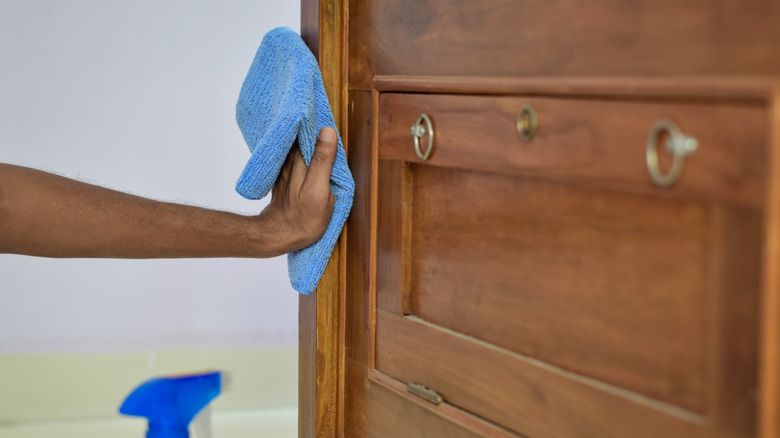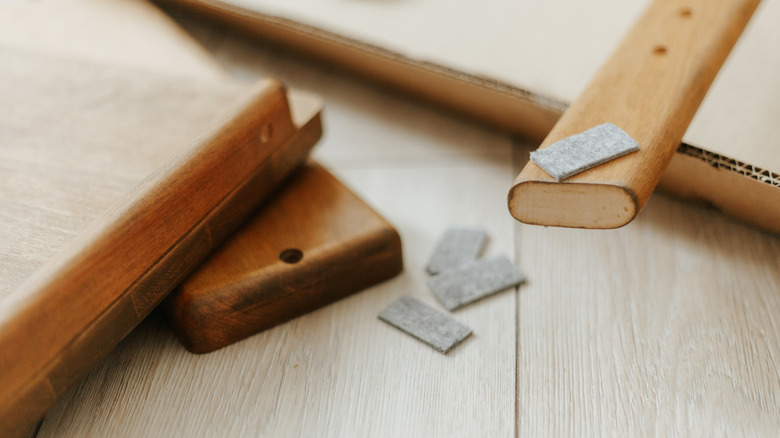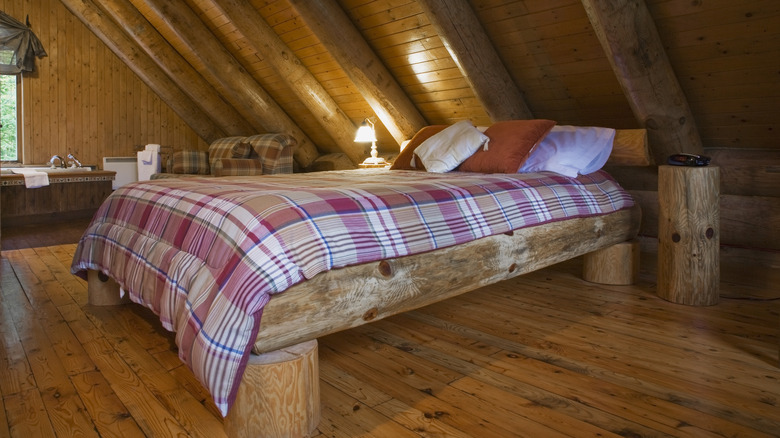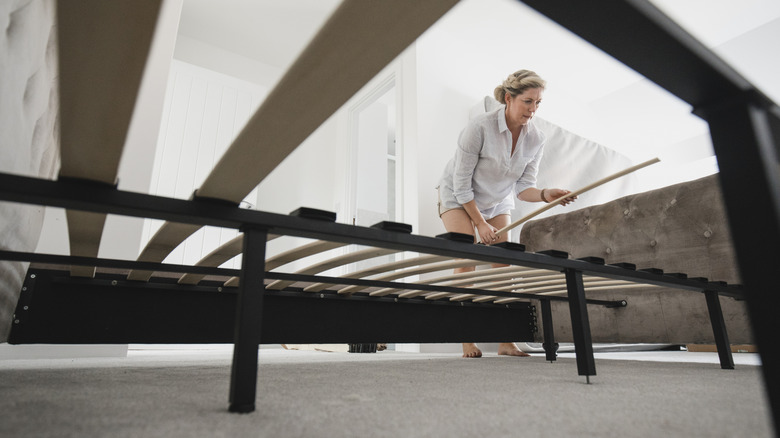Protect Your Wood Bed Frame From Damage With These Easy Habits
Your bed frame is more than just an anchor or backdrop for the rest of your room. While it can certainly help to feng shui your bedroom, it's also a statement piece that creates more dimension and visual interest in your sleeping space. If you have a wood frame, you may notice over time it has become a little weathered and worn, which is normal for any natural material. However, as an expensive addition that you may not want to have to upgrade too often, keeping it in good condition should be a priority.
So how do you care for such a large fixture, and what factors negatively affect your frame? Like other wood pieces in your home, bed frames need polishing, regular cleaning, ventilation, protection from too much moisture, and proper sunlight exposure to avoid fading, wear and tear, warping, and other detrimental issues. By adjusting a few elements within your space and your routine, you can help your bed frame last longer and continue to provide style as well as comfort in your space.
Check your humidity levels
When it comes to wood, the moisture and humidity levels in your home can make a big difference to the natural material. If your space has too much moisture in the air, your wood could begin to grow fungus. However, if your bed frame gets too dry from a lack of humidity, this is when warping and other issues could occur. It's ideal to keep the humidity levels in your home at a minimum of 40%, and try to avoid more than 60%.
Depending on where you live and the weather, you may need to invest in humidifiers. As the seasons change, keep an eye on both your moisture levels within the home and your general temperatures. 65 to 70 degrees Fahrenheit is usually a good number to help wood stay in good condition. You can also add wood sealant to your frame to help protect against too much moisture in the air.
Clean your frame regularly
Regularly dust your bed frame to prevent dirt from accumulating. Polishing it can help protect against wear and tear, too. Wood polish and wax create a barrier that also nourishes your materials. Depending on the wood and the finish, your supplies might vary, so always check what the ideal cleaner and polish is for your frame. Once you've applied wood wax, make sure you are regularly dusting your frame and reapplying the wax once a year.
It might be worth investing in a bed frame that is already sealed rather than raw or unfinished wood. This way, you already have a protective barrier against wear and tear. When it comes to how you should be cleaning your wood furniture, using microfiber cloths and gentle cleansers will help to make the wood glow without scuffing or scratching it, so opt for non-abrasive supplies whenever you are wiping down the frame. Maintaining your wood also means you can always repurpose an old bed frame around your home or garden and still get a stylish aesthetic thanks to the good condition of the wood.
Protect against scuffs with furniture pads
Furniture pads are useful when it comes to protecting your bed frame. Not only do these prevent scratches, but they also protect the floor and any areas around the frame, too. Adding these pads to the portion of your frame that touches the walls keeps both the wood and the walls free of scuffs. If you do have a frame that features shelves or storage, you can also use pads under items like lamps or Knick knacks to keep scratches from damaging the finish. Placing rubber pads under your wood bed frame legs will help hold it in place on hard flooring.
Whenever you do shift your furniture, use fabric or bubble wrap around the frame. This will keep it from getting scuffed or bumped and scratched too. Always keep the corners in mind when wrapping your bed frame as these are the most likely to get scuffed. Blankets can also work for this purpose if you don't have bubble wrap on hand, just use thicker quilts when moving the frame further distances.
Avoid too much sunlight on wood pieces
Another factor to consider when you have a wood bed frame or any wood furniture is sunshine. This glorious natural light can fade wood so that it comes across dull, worn, and cracked even if it is brand new. Because of this, it may be helpful to place pieces of wood furniture, especially your frame, away from direct sunlight. For most rooms this should be simple, but if you have an oddly shaped room or a lot of windows, you may have to play around with the layout to avoid intense UV rays shining on your frame.
Window treatments can help protect wood, keeping the harshest rays at bay during peak house. Use blinds or shutters that absorb heat and UV rays, or consider blackout curtains. While natural light is great to have in your home, if you want your furnishings to last longer it may be more ideal to limit it when you can. Plus, this could help lower utility costs, especially during the warmer months.
Reinforce and support older wood frames
Lastly, some wooden bed frames may be vintage or antique pieces, which means they may need to be reinforced over time. If your frame is older, consider adding newer pieces of wood to stabilize or hold it up. You can also install metal brackets or go around and make sure all the bolts or screws are tight. Wood beams and slats will help to keep the frame sturdy, or extra plywood is useful for a sagging middle section.
Depending on which areas of the bed need more stability, this could be a wood beam added to the center or multiple slats underneath. Wood glue is another option in the corners to add a little more security, and swapping out the legs of the frame might contribute to a more solid base. Figure out which areas of the frame need work, then focus on those and monitor the overall finish to determine if more reinforcement is needed.





